Triskelion
A triskelion or triskeles is a motif consisting of a triple spiral exhibiting rotational symmetry. The spiral design can be based on interlocking Archimedean spirals, or represent three bent human legs.

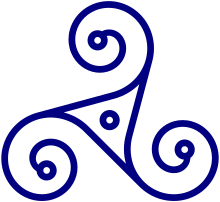
The triple spiral is found in artefacts of the European Neolithic and Bronze Age with continuation into the Iron Age especially in the context of the La Tène culture and related Celtic traditions. The actual triskeles symbol of three human legs is found especially in Greek antiquity, beginning in archaic pottery, and continued in coinage of the classical period. In the Hellenistic period, the symbol becomes associated with Sicily in particular, appearing on coins minted under Dionysius I of Syracuse beginning in c. 382 BC.[1] The same symbol later appears in heraldry, and came to be associated specifically with the Isle of Man (known as ny tree cassyn "the three legs").[2]
Greek τρισκελής (triskeles) means "three-legged".[3] While the Greek adjective τρισκελής "three-legged [e.g. of a table]" is ancient, use of the term for the symbol is modern, introduced in 1835 by Honoré Théodoric d'Albert de Luynes as French triskèle,[4] and adopted in the spelling triskeles following Otto Olshausen (1886).[5] The form triskelion (as it were Greek τρισκέλιον[6]) is a diminutive which entered English usage in numismatics in the late 19th century.[7][8] The form consisting of three human legs (as opposed to the triple spiral) has also been called a "triquetra of legs" or triskelos, triskel.[9]
Use in European antiquity
Neolithic to Bronze Age
The triple spiral symbol, or three spiral volute, appears in many early cultures, the first in Malta (4400–3600 BCE) and in the astronomical calendar at the famous megalithic tomb of Newgrange in Ireland built around 3200 BCE,[10] as well as on Mycenaean vessels.
The Neolithic era symbol of three conjoined spirals may have had triple significance similar to the imagery that lies behind the triskelion..[11] It is carved into the rock of a stone lozenge near the main entrance of the prehistoric Newgrange monument in County Meath, Ireland. Newgrange, which was built around 3200 BCE.[10]
Classical Antiquity

The triskeles proper, composed of three human legs, is younger than the triple spiral, found in decorations on Greek pottery especially as a design shown on hoplite shields, and later also minted on Greek and Anatolian coinage. An early example is found on the shield of Achilles in an Attic hydria of the late 6th century BCE.[12] It is found on coinage in Lycia, and on staters of Pamphylia (at Aspendos, 370–333 BCE) and Pisidia.
The meaning of the Greek triskeles is not recorded directly. The Duc de Luynes in his 1835 study noted the co-occurrence of the symbol with the eagle, the cockerel, the head of Medusa, Perseus, three crescent moons, three ears of corn, and three grains of corn. From this, he reconstructed feminine divine triad which he identified with the "triple goddess" Hecate.[4]
The triskeles was adopted as emblem by the rulers of Syracuse. It is possible that this usage is related with the Greek name of the island of Sicily, Trinacria (Τρινακρία "having three headlands").[13] The Sicilian triskeles is shown with the head of Medusa at the center.[14] The ancient symbol has been re-introduced in modern flags of Sicily since 1848.
Roman period and Late Antiquity
Late examples of the triple spiral symbols are found in Iron Age Europe, e.g. carved in rock in Castro Culture settlement in Galicia, Asturias and Northern Portugal. In Ireland before the 5th century, in Celtic Christianity the symbol took on new meaning, as a symbol of the Trinity (Father, Son, and Holy Spirit).
Medieval use
The triple spiral design is found as a decorative element in Gothic architecture. The three legs (triskeles) symbol is rarely found as a charge in late medieval heraldry, notably as the arms of the King of Mann (Armorial Wijnbergen, c. 1280), and as canting arms in the city seal of the Bavarian city of Füssen (dated 1317).
Modern usage
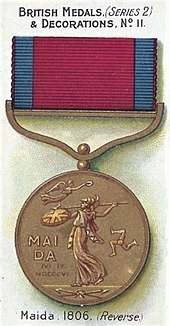
The triskeles was included in the design of the Army Gold Medal awarded to British Army majors and above who had taken a key part in the Battle of Maida (1806).[15] An early flag of Sicily, proposed in 1848, included the Sicilian triskeles or "Trinacria symbol". Later versions of Sicilian flags have retained the emblem, including the one officially adopted in 2000. The Flag of the Isle of Man (1932) shows a heraldic design of a triskeles of three armoured legs.
The triple spiral, or the "horned triskelion", is used by some polytheistic reconstructionist or neopagan groups. As a "Celtic symbol", it is used primarily by groups with a Celtic cultural orientation and, less frequently, can also be found in use by various eclectic or syncretic traditions such as Neopaganism. The spiral triskele is one of the primary symbols of Celtic Reconstructionist Paganism, used to represent a variety of triplicities in cosmology and theology; it is also a favored symbol due to its association with the god Manannán mac Lir.[16]
Other uses loosely inspired by the triskelion as a "Celtic" symbol include the crest of the Breton football club En Avant de Guingamp, which combines the Flag of Brittany, the team colours and the triple spiral triskelion. and the triskelion-like design of the roundel of the Irish Air Corps,[17]
Other uses of triskelion-like emblems include the logo for the Trisquel Linux distribution, the seal of the United States Department of Transportation,[18] and the design of RCA's "Spider" 45 rpm adapter (adopted as a popular symbol for record and music enthusiasts).[19][20] Afrikaner Weerstandsbeweging, an Afrikaner nationalist organization and political party (founded 1973), uses a triskele composed of three sevens as its symbol in place of the Nazi swastika. Use of a triskelion-derived emblem has been reported for parts of the BDSM community in 2012.[21] "The Gamesters of Triskelion" is a second-season episode of the American science fiction television series Star Trek. In the Marvel Universe, the intelligence agency S.H.I.E.L.D. uses the Triskelion as its headquarters . The Triskele is also used as a prominent symbol in MTV's Teen Wolf (2011) which draws heavily from Celtic mythology. In the television series Merlin it was used as symbol of druids. In anime Nanatsu no Taizai it is used as symbol of goddesses clan.
Occurrence in nature
The endocytic protein, clathrin, is triskelion-shaped.[22] The Ediacaran fossil Tribrachidium is also triskelion shaped.
Gallery
Antiquity
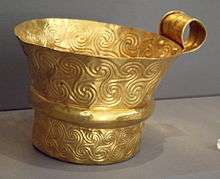 Gold cup from Mycenae decorated with triskelions, in the National Archaeological Museum of Athens.
Gold cup from Mycenae decorated with triskelions, in the National Archaeological Museum of Athens.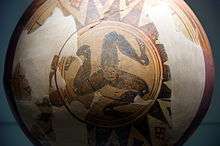 Triskelion of Sicily of the Minoan period (archaeological museum of Agrigento)
Triskelion of Sicily of the Minoan period (archaeological museum of Agrigento) Late Helladic (14th century BC) beaked jug decorated with triple spirals
Late Helladic (14th century BC) beaked jug decorated with triple spirals
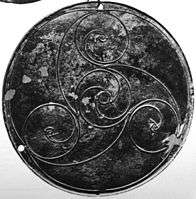 Celtic (Iron Age) bronze disk (Longban Island, Derry), with a triskele of three stylized bird heads with whorl in the center
Celtic (Iron Age) bronze disk (Longban Island, Derry), with a triskele of three stylized bird heads with whorl in the center Continental Celtic (La Tène period) electrum "rainbow cup" with triskele
Continental Celtic (La Tène period) electrum "rainbow cup" with triskele
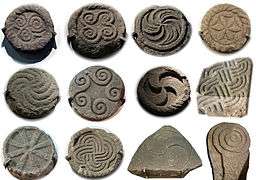 Selection of carvings from the Castro of Santa Trega, Galicia (late La Tène or early Roman period)
Selection of carvings from the Castro of Santa Trega, Galicia (late La Tène or early Roman period)- Triskelion and spirals on a Galician torc terminal.
Medieval architecture

 On the front of Abbatial church of Saint-Antoine-l'Abbaye with 2 groups of 2 triskelions and 1 biskel (in Isère / France)
On the front of Abbatial church of Saint-Antoine-l'Abbaye with 2 groups of 2 triskelions and 1 biskel (in Isère / France)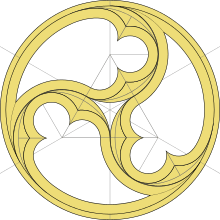 Triskele of church windows
Triskele of church windows
Modern flags and emblems
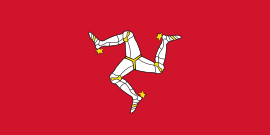 The flag of the Isle of Man (1932)
The flag of the Isle of Man (1932)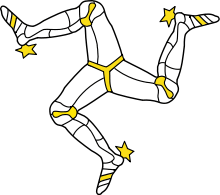 Triskelion found on the Flag of the Isle of Man (based on the 13th-century arms of the King of Mann)
Triskelion found on the Flag of the Isle of Man (based on the 13th-century arms of the King of Mann)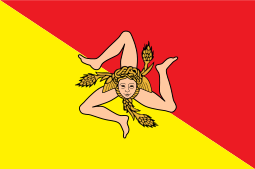 The flag of Sicily, with the triskeles-and-Gorgoneion symbol
The flag of Sicily, with the triskeles-and-Gorgoneion symbol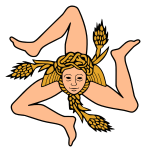 Triskeles of Sicily (with wings and ears of corns, 1940s design, based on the emblem found on coins minted in Syracuse in the Hellenistic period)
Triskeles of Sicily (with wings and ears of corns, 1940s design, based on the emblem found on coins minted in Syracuse in the Hellenistic period) Canting arms of the town of Füssen, Bavaria (based on a 14th-century heraldic design)
Canting arms of the town of Füssen, Bavaria (based on a 14th-century heraldic design) Irish Air Corps roundel, a modern interpretation of the Celtic triskele
Irish Air Corps roundel, a modern interpretation of the Celtic triskele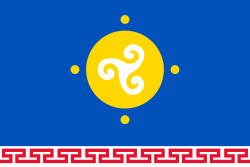 Flag of Ust-Orda Buryat Okrug
Flag of Ust-Orda Buryat Okrug
 Red triskelion found on the flag of Ingushetia (1994)
Red triskelion found on the flag of Ingushetia (1994) The seal of the US Department of Transportation.
The seal of the US Department of Transportation. Antahkarana - computer's radio waves protection
Antahkarana - computer's radio waves protection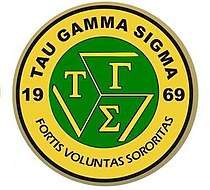 The seal of Tau Gamma Sigma sorority
The seal of Tau Gamma Sigma sorority
See also
- Armenian Eternity sign
- Borromean rings
- Celtic knot
- Dragon's Eye
- Fylfot
- Gankyil
- Hypogeum of Ħal-Saflieni
- Isle of Man
- Megalithic Temples of Malta
- Snoldelev Stone
- Swastika
- Taegeuk
- Three hares
- Three-legged crow
- Tomoe
- Trefoil
- Tripod
- Triquetra
- Valknut
- Sharingan
- Western use of the swastika in the early 20th century
- Yin and yang
References
| Wikimedia Commons has media related to Triskelion. |
- Arthur Bernard Cook, Zeus: a study in ancient religion, Volume 3, Part 2 (1940), p. 1074.
- Adopted in 1932, the flag of the Isle of Man is derived from the arms of the King of Mann recorded in the 13th century.
- τρισκελής, Henry George Liddell, Robert Scott, A Greek-English Lexicon, on Perseus Digital Library; from τρι- (tri-), "three times" (τρι- Archived 2012-10-04 at the Wayback Machine, Henry George Liddell, Robert Scott, A Greek-English Lexicon, on Perseus Digital Library) and "σκέλος" (skelos), "leg (σκέλος, Henry George Liddell, Robert Scott, A Greek–English Lexicon, on Perseus Digital Library)
- Honore-Theodoric-Paul-Joseph d'Albert de Luynes, Etudes numismatiques sur quelques types relatifs au culte d'Hecate (1835), 83f.
- Johannes Maringer, "Das Triskeles in der vor- und frühgeschichtlichen Kunst", Anthropos 74.3/4 (1979), pp. 566-576
- Classical Greek does not have *τρισκέλιον, but the form τρισκελίδιον "small tripod" is on record as the diminutive of τρισκελίς "three-pronged". The form τρισκέλιον does exist in Katharevousa, however, as the term for a small three-legged chair or table (and also of the "Rule of Three" in elematary arithmetics or generally of an analogy). Adamantios Korais, Atakta (Modern Greek Dictionary), vol. 5 (1835), p. 54.
- Barclay Vincent Head, A Guide to the Principal Gold and Silver Coins of the Ancients: From Circ. B.C. 700 to A.D. 1, British Museum. Department of Coins and Medals , The Trustees, 1881, pp. 23, 67f.
- English triskelion is recorded in 1880 (etymonline.com); the form triskele in English is occasionally found beginning in c. 1885 (e.g. in Proceedings of the Literary and Philosophical Society of Liverpool 39, 1885, p. 220), presumably as a direct representation of the French form triskèle.
- Samuel Birch, Charles Thomas Newton, A Catalogue of the Greek and Etruscan Vases in the British Museum vol. 1 (1851), p. 61. Samuel Birch, History of Ancient Pottery vol. 1 (1858), p. 164. Birch's use of triskelos is informed by the Duc de Luynes' triskèle, and it continues to see some use alongside the better-formed triskeles into the 20th century in both English and German, e.g. in a 1932 lecture by C. G. Jung (lecture of 26 October, edited in The Psychology of Kundalini Yoga: Notes of the Seminar Given in 1932. 1996, 43ff.).
- "Newgrange Ireland - Megalithic Passage Tomb - World Heritage Site". Knowth.com. 2007-12-21. Retrieved 2013-08-16.
- Anthony Murphy and Richard Moore, Island of the Setting Sun: In Search of Ireland's Ancient Astronomers, 2nd ed., Dublin: The Liffey Press, 2008, pp. 168–169
- Boston Museum of Fine Arts, illustrated in John Boardman, Jasper Griffin and Oswyn Murray, Greece and the Hellenistic World (Oxford History of the Classical World) vol. I (1988), p. 50.
- Liddell and Scott’s Greek-English Lexicon (A Lexicon Abridged from), Oxford, 1944, p.27, Cassell's Latin Dictionary, Marchant, J.R.V, & Charles, Joseph F., (Eds.), Revised Edition, 1928
- Matthews, Jeff (2005) Symbols of Naples Archived 2009-10-30 at the Wayback Machine
- Charles Norton Elvin, A Dictionary of Heraldry (1889), p. 126.
- Bonewits, Isaac (2006) Bonewits's Essential Guide to Druidism. New York, Kensington Publishing Group ISBN 0-8065-2710-2. p. 132: [Among Celtic Reconstructionists] "...An Thríbhís Mhòr (the great triple spiral) came into common use to refer to the three realms." Also p. 134: [On CRs] "Using Celtic symbols such as triskeles and spirals"
- The Aircraft Encyclopedia by Roy Braybrook, 1985, ISBN 0-671-55337-2, p. 51
- Kane, Robert M. (1 January 2019). "Air Transportation". Kendall Hunt – via Google Books.
- "We Love Life: Music - 45 RPM Adapters". Welove-music.com. 2009-11-26. Archived from the original on 2009-12-02. Retrieved 2013-08-16.
- "Boing Boing: Gadgets - Twenty 45 adapters". Gadgets.boingboing.net. 2008-12-05. Retrieved 2013-08-16.
- Luminais, Misty (May 2012). In the Habit of Being Kinky: Practice and Resistance in a BDSM Community, Texas, USA (PDF). Washington State University. p. 121. Retrieved 10 November 2014. "A couple of younger people said that wearing a triskelion, a symbol of three interlocking spirals, was an indication that a person was into BDSM. [...] The triskelion was popular in the New Age movement and among sci-fi/fantasy aficionados, so it was not always apparent that it was being worn as an indication of kinky affiliation." (2012, citing Wikipedia)
- https://www.ebi.ac.uk/interpro/potm/2007_4/Page1.htm
